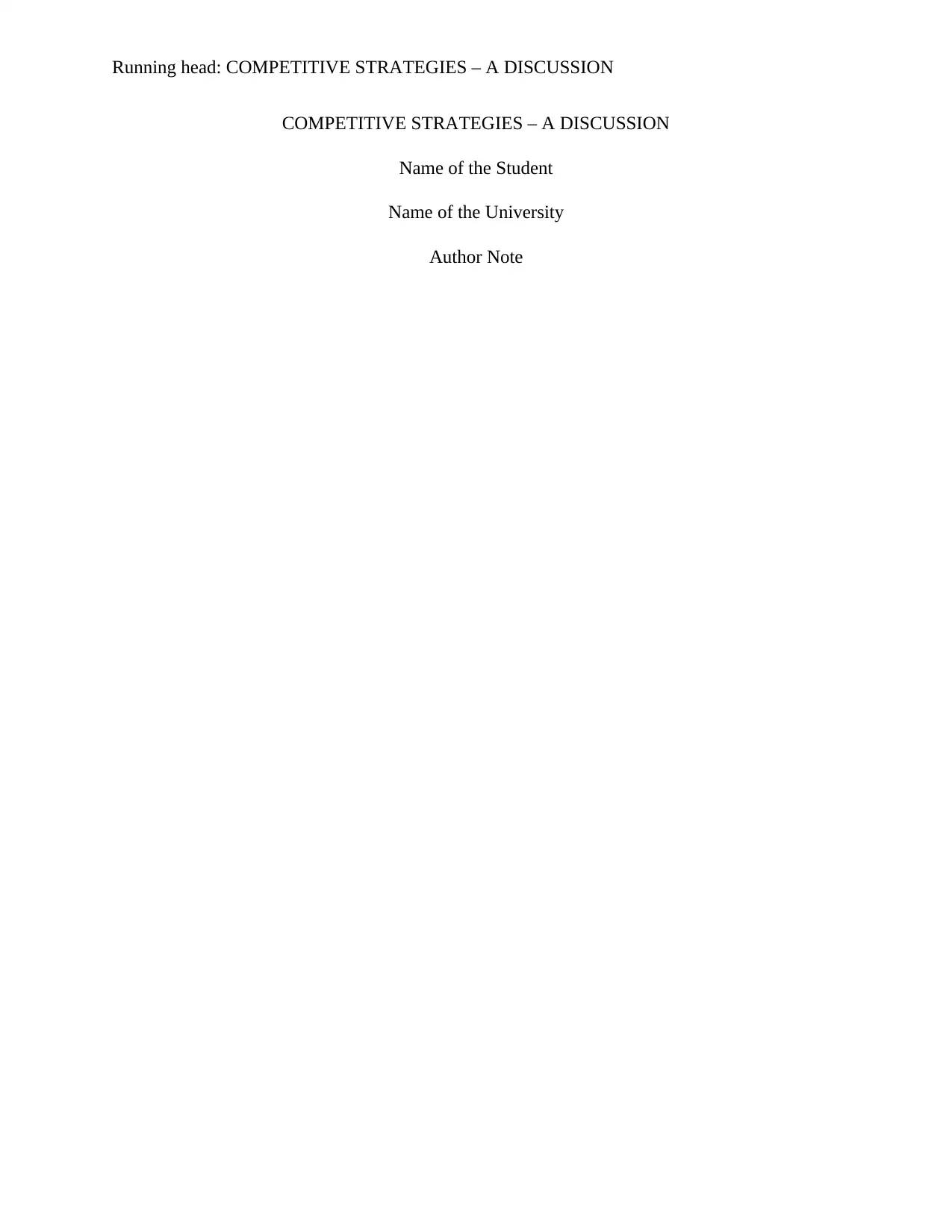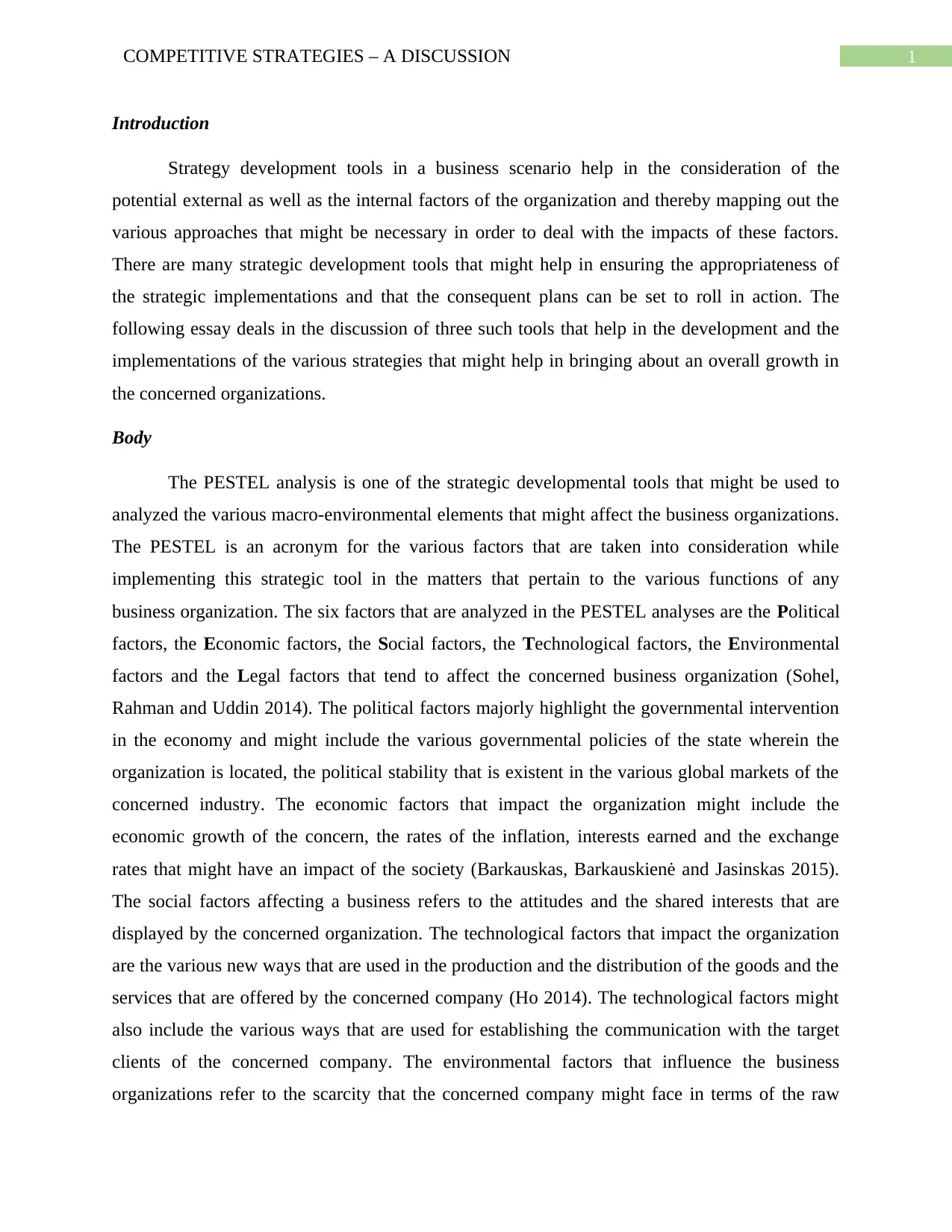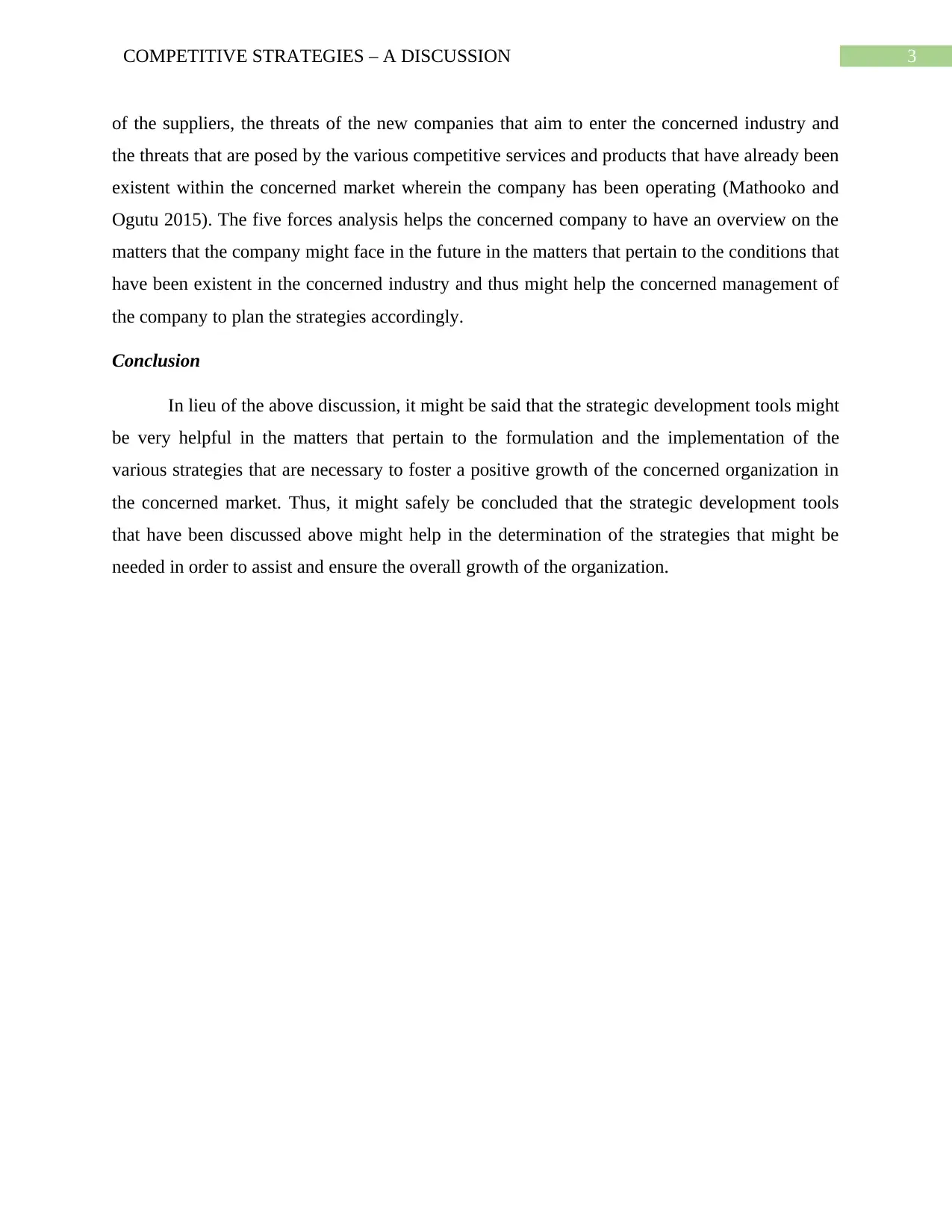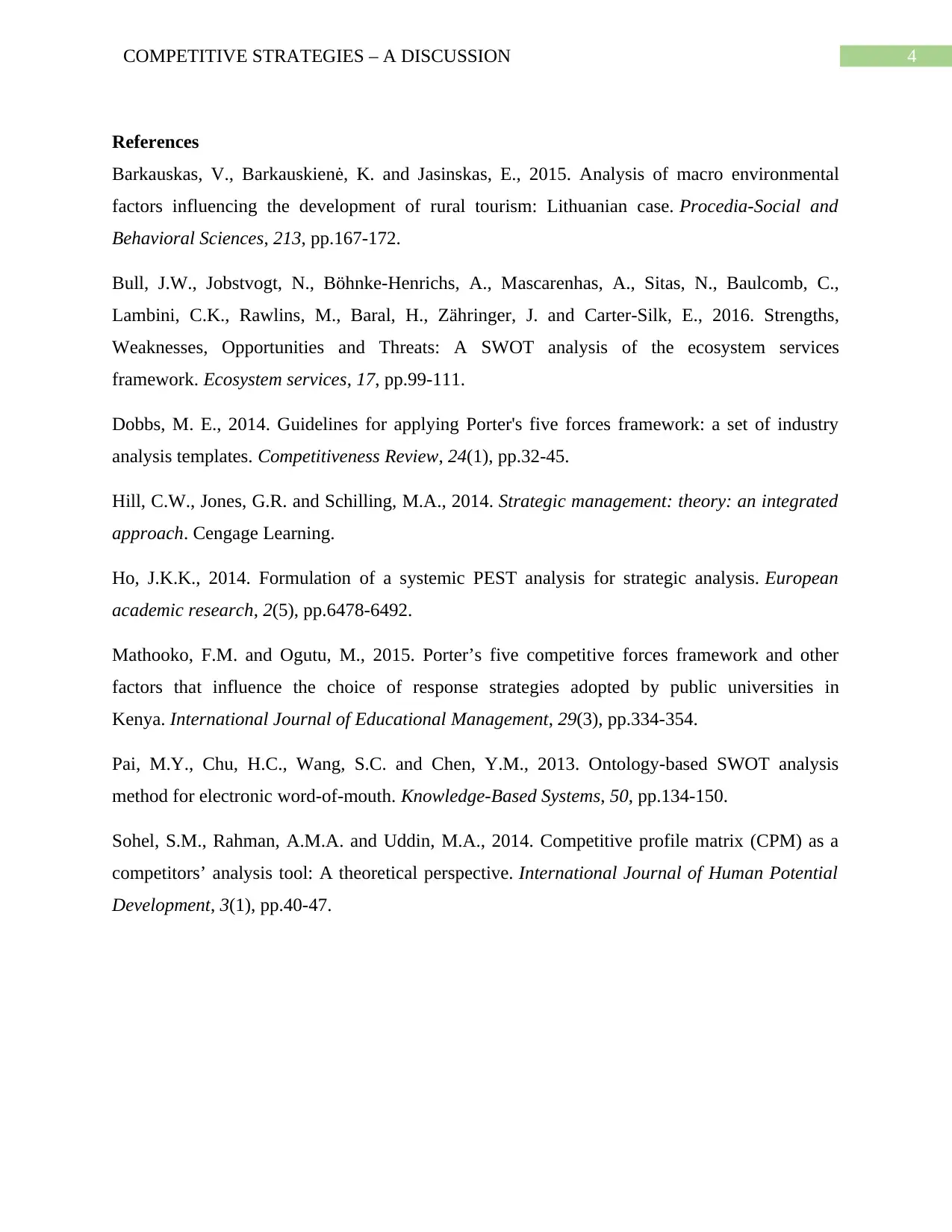Analysis of Strategy Development Tools: PESTEL, SWOT, and Five Forces
VerifiedAdded on 2023/06/13
|5
|1486
|346
Essay
AI Summary
This essay provides a comprehensive discussion of strategy development tools used in business, focusing on PESTEL analysis, SWOT analysis, and Porter's Five Forces model. It explains how PESTEL analyzes macro-environmental factors (Political, Economic, Social, Technological, Environmental, and Legal) affecting businesses. The essay details how SWOT analysis identifies Strengths, Weaknesses, Opportunities, and Threats to inform strategic decisions. Furthermore, it elucidates Porter's Five Forces, which examines industry rivalry, buyer and supplier power, new entrants, and substitute products. The essay concludes that these tools are essential for formulating and implementing strategies that foster organizational growth and competitive advantage in the market.

Running head: COMPETITIVE STRATEGIES – A DISCUSSION
COMPETITIVE STRATEGIES – A DISCUSSION
Name of the Student
Name of the University
Author Note
COMPETITIVE STRATEGIES – A DISCUSSION
Name of the Student
Name of the University
Author Note
Paraphrase This Document
Need a fresh take? Get an instant paraphrase of this document with our AI Paraphraser

1COMPETITIVE STRATEGIES – A DISCUSSION
Introduction
Strategy development tools in a business scenario help in the consideration of the
potential external as well as the internal factors of the organization and thereby mapping out the
various approaches that might be necessary in order to deal with the impacts of these factors.
There are many strategic development tools that might help in ensuring the appropriateness of
the strategic implementations and that the consequent plans can be set to roll in action. The
following essay deals in the discussion of three such tools that help in the development and the
implementations of the various strategies that might help in bringing about an overall growth in
the concerned organizations.
Body
The PESTEL analysis is one of the strategic developmental tools that might be used to
analyzed the various macro-environmental elements that might affect the business organizations.
The PESTEL is an acronym for the various factors that are taken into consideration while
implementing this strategic tool in the matters that pertain to the various functions of any
business organization. The six factors that are analyzed in the PESTEL analyses are the Political
factors, the Economic factors, the Social factors, the Technological factors, the Environmental
factors and the Legal factors that tend to affect the concerned business organization (Sohel,
Rahman and Uddin 2014). The political factors majorly highlight the governmental intervention
in the economy and might include the various governmental policies of the state wherein the
organization is located, the political stability that is existent in the various global markets of the
concerned industry. The economic factors that impact the organization might include the
economic growth of the concern, the rates of the inflation, interests earned and the exchange
rates that might have an impact of the society (Barkauskas, Barkauskienė and Jasinskas 2015).
The social factors affecting a business refers to the attitudes and the shared interests that are
displayed by the concerned organization. The technological factors that impact the organization
are the various new ways that are used in the production and the distribution of the goods and the
services that are offered by the concerned company (Ho 2014). The technological factors might
also include the various ways that are used for establishing the communication with the target
clients of the concerned company. The environmental factors that influence the business
organizations refer to the scarcity that the concerned company might face in terms of the raw
Introduction
Strategy development tools in a business scenario help in the consideration of the
potential external as well as the internal factors of the organization and thereby mapping out the
various approaches that might be necessary in order to deal with the impacts of these factors.
There are many strategic development tools that might help in ensuring the appropriateness of
the strategic implementations and that the consequent plans can be set to roll in action. The
following essay deals in the discussion of three such tools that help in the development and the
implementations of the various strategies that might help in bringing about an overall growth in
the concerned organizations.
Body
The PESTEL analysis is one of the strategic developmental tools that might be used to
analyzed the various macro-environmental elements that might affect the business organizations.
The PESTEL is an acronym for the various factors that are taken into consideration while
implementing this strategic tool in the matters that pertain to the various functions of any
business organization. The six factors that are analyzed in the PESTEL analyses are the Political
factors, the Economic factors, the Social factors, the Technological factors, the Environmental
factors and the Legal factors that tend to affect the concerned business organization (Sohel,
Rahman and Uddin 2014). The political factors majorly highlight the governmental intervention
in the economy and might include the various governmental policies of the state wherein the
organization is located, the political stability that is existent in the various global markets of the
concerned industry. The economic factors that impact the organization might include the
economic growth of the concern, the rates of the inflation, interests earned and the exchange
rates that might have an impact of the society (Barkauskas, Barkauskienė and Jasinskas 2015).
The social factors affecting a business refers to the attitudes and the shared interests that are
displayed by the concerned organization. The technological factors that impact the organization
are the various new ways that are used in the production and the distribution of the goods and the
services that are offered by the concerned company (Ho 2014). The technological factors might
also include the various ways that are used for establishing the communication with the target
clients of the concerned company. The environmental factors that influence the business
organizations refer to the scarcity that the concerned company might face in terms of the raw

2COMPETITIVE STRATEGIES – A DISCUSSION
materials that are needed, the factors that pertain to the ethics and the sustainability that is
expected of the organization and the footprint targets that are set by the government. The legal
factors that influence the company might include the health and the safety measures that are
maintained by the company, the equality in the opportunities that the company might extend to
the employees, the standards that are maintained by the company in the advertising matters, the
laws and the rights that the company maintains for the concerned clients of the company.
The results of the PESTEL analyses are further used in the identification of the various
strengths and the weaknesses of the concerned organization and thus helps in conducting the
SWOT Analysis of the company. The SWOT analysis is another strategic development tool that
is used by the various companies in order to make an analysis of the micro-environmental factors
that might affect the concerned organization. SWOT is an acronym for the Strengths, the
Weaknesses, the Opportunities and the Threats that might be faced by the concerned company
(Hill, Jones and Schilling 2014). The analysis aims to identify and prioritize the various
strengths, weaknesses, opportunities and the threats that might be faced by the company in the
future. The identification of the strengths of the organization might relate to the various factors
that might assist the growth of the company, the opportunities deals with the areas that might
help the organization in the further growth (Bull et al. 2016). The weaknesses of an organization
point at the factors that need to be looked into by the concerned management of the organization.
The threats of the organization refer to the points of the organization that might pose to be a
hindrance in the overall growth of the organization (Pai et al. 2013). The SWOT analysis helps
the concerned management of the organization to identify the areas that might help the
concerned business organization to experience a positive growth and the areas that need to be
attended to in order to avoid the deterioration of the company in the concerned matters.
The other major strategic development and planning tool that might be used by the
concerned organizations is the five forces model of strategic planning. This model also known as
the Porter’s five forces model of strategic planning was introduced by Michael Porter in the year
1980. This model of strategic planning was first brought up in the book titled Competitive
Strategy and deals with the five critical forces that might have an impact on the strategic
planning of the concerned organization (Dobbs 2014). These factors generally include the rivalry
that exists in the concerned industry, the bargaining powers of the buyers, the bargaining power
materials that are needed, the factors that pertain to the ethics and the sustainability that is
expected of the organization and the footprint targets that are set by the government. The legal
factors that influence the company might include the health and the safety measures that are
maintained by the company, the equality in the opportunities that the company might extend to
the employees, the standards that are maintained by the company in the advertising matters, the
laws and the rights that the company maintains for the concerned clients of the company.
The results of the PESTEL analyses are further used in the identification of the various
strengths and the weaknesses of the concerned organization and thus helps in conducting the
SWOT Analysis of the company. The SWOT analysis is another strategic development tool that
is used by the various companies in order to make an analysis of the micro-environmental factors
that might affect the concerned organization. SWOT is an acronym for the Strengths, the
Weaknesses, the Opportunities and the Threats that might be faced by the concerned company
(Hill, Jones and Schilling 2014). The analysis aims to identify and prioritize the various
strengths, weaknesses, opportunities and the threats that might be faced by the company in the
future. The identification of the strengths of the organization might relate to the various factors
that might assist the growth of the company, the opportunities deals with the areas that might
help the organization in the further growth (Bull et al. 2016). The weaknesses of an organization
point at the factors that need to be looked into by the concerned management of the organization.
The threats of the organization refer to the points of the organization that might pose to be a
hindrance in the overall growth of the organization (Pai et al. 2013). The SWOT analysis helps
the concerned management of the organization to identify the areas that might help the
concerned business organization to experience a positive growth and the areas that need to be
attended to in order to avoid the deterioration of the company in the concerned matters.
The other major strategic development and planning tool that might be used by the
concerned organizations is the five forces model of strategic planning. This model also known as
the Porter’s five forces model of strategic planning was introduced by Michael Porter in the year
1980. This model of strategic planning was first brought up in the book titled Competitive
Strategy and deals with the five critical forces that might have an impact on the strategic
planning of the concerned organization (Dobbs 2014). These factors generally include the rivalry
that exists in the concerned industry, the bargaining powers of the buyers, the bargaining power
⊘ This is a preview!⊘
Do you want full access?
Subscribe today to unlock all pages.

Trusted by 1+ million students worldwide

3COMPETITIVE STRATEGIES – A DISCUSSION
of the suppliers, the threats of the new companies that aim to enter the concerned industry and
the threats that are posed by the various competitive services and products that have already been
existent within the concerned market wherein the company has been operating (Mathooko and
Ogutu 2015). The five forces analysis helps the concerned company to have an overview on the
matters that the company might face in the future in the matters that pertain to the conditions that
have been existent in the concerned industry and thus might help the concerned management of
the company to plan the strategies accordingly.
Conclusion
In lieu of the above discussion, it might be said that the strategic development tools might
be very helpful in the matters that pertain to the formulation and the implementation of the
various strategies that are necessary to foster a positive growth of the concerned organization in
the concerned market. Thus, it might safely be concluded that the strategic development tools
that have been discussed above might help in the determination of the strategies that might be
needed in order to assist and ensure the overall growth of the organization.
of the suppliers, the threats of the new companies that aim to enter the concerned industry and
the threats that are posed by the various competitive services and products that have already been
existent within the concerned market wherein the company has been operating (Mathooko and
Ogutu 2015). The five forces analysis helps the concerned company to have an overview on the
matters that the company might face in the future in the matters that pertain to the conditions that
have been existent in the concerned industry and thus might help the concerned management of
the company to plan the strategies accordingly.
Conclusion
In lieu of the above discussion, it might be said that the strategic development tools might
be very helpful in the matters that pertain to the formulation and the implementation of the
various strategies that are necessary to foster a positive growth of the concerned organization in
the concerned market. Thus, it might safely be concluded that the strategic development tools
that have been discussed above might help in the determination of the strategies that might be
needed in order to assist and ensure the overall growth of the organization.
Paraphrase This Document
Need a fresh take? Get an instant paraphrase of this document with our AI Paraphraser

4COMPETITIVE STRATEGIES – A DISCUSSION
References
Barkauskas, V., Barkauskienė, K. and Jasinskas, E., 2015. Analysis of macro environmental
factors influencing the development of rural tourism: Lithuanian case. Procedia-Social and
Behavioral Sciences, 213, pp.167-172.
Bull, J.W., Jobstvogt, N., Böhnke-Henrichs, A., Mascarenhas, A., Sitas, N., Baulcomb, C.,
Lambini, C.K., Rawlins, M., Baral, H., Zähringer, J. and Carter-Silk, E., 2016. Strengths,
Weaknesses, Opportunities and Threats: A SWOT analysis of the ecosystem services
framework. Ecosystem services, 17, pp.99-111.
Dobbs, M. E., 2014. Guidelines for applying Porter's five forces framework: a set of industry
analysis templates. Competitiveness Review, 24(1), pp.32-45.
Hill, C.W., Jones, G.R. and Schilling, M.A., 2014. Strategic management: theory: an integrated
approach. Cengage Learning.
Ho, J.K.K., 2014. Formulation of a systemic PEST analysis for strategic analysis. European
academic research, 2(5), pp.6478-6492.
Mathooko, F.M. and Ogutu, M., 2015. Porter’s five competitive forces framework and other
factors that influence the choice of response strategies adopted by public universities in
Kenya. International Journal of Educational Management, 29(3), pp.334-354.
Pai, M.Y., Chu, H.C., Wang, S.C. and Chen, Y.M., 2013. Ontology-based SWOT analysis
method for electronic word-of-mouth. Knowledge-Based Systems, 50, pp.134-150.
Sohel, S.M., Rahman, A.M.A. and Uddin, M.A., 2014. Competitive profile matrix (CPM) as a
competitors’ analysis tool: A theoretical perspective. International Journal of Human Potential
Development, 3(1), pp.40-47.
References
Barkauskas, V., Barkauskienė, K. and Jasinskas, E., 2015. Analysis of macro environmental
factors influencing the development of rural tourism: Lithuanian case. Procedia-Social and
Behavioral Sciences, 213, pp.167-172.
Bull, J.W., Jobstvogt, N., Böhnke-Henrichs, A., Mascarenhas, A., Sitas, N., Baulcomb, C.,
Lambini, C.K., Rawlins, M., Baral, H., Zähringer, J. and Carter-Silk, E., 2016. Strengths,
Weaknesses, Opportunities and Threats: A SWOT analysis of the ecosystem services
framework. Ecosystem services, 17, pp.99-111.
Dobbs, M. E., 2014. Guidelines for applying Porter's five forces framework: a set of industry
analysis templates. Competitiveness Review, 24(1), pp.32-45.
Hill, C.W., Jones, G.R. and Schilling, M.A., 2014. Strategic management: theory: an integrated
approach. Cengage Learning.
Ho, J.K.K., 2014. Formulation of a systemic PEST analysis for strategic analysis. European
academic research, 2(5), pp.6478-6492.
Mathooko, F.M. and Ogutu, M., 2015. Porter’s five competitive forces framework and other
factors that influence the choice of response strategies adopted by public universities in
Kenya. International Journal of Educational Management, 29(3), pp.334-354.
Pai, M.Y., Chu, H.C., Wang, S.C. and Chen, Y.M., 2013. Ontology-based SWOT analysis
method for electronic word-of-mouth. Knowledge-Based Systems, 50, pp.134-150.
Sohel, S.M., Rahman, A.M.A. and Uddin, M.A., 2014. Competitive profile matrix (CPM) as a
competitors’ analysis tool: A theoretical perspective. International Journal of Human Potential
Development, 3(1), pp.40-47.
1 out of 5
Related Documents
Your All-in-One AI-Powered Toolkit for Academic Success.
+13062052269
info@desklib.com
Available 24*7 on WhatsApp / Email
![[object Object]](/_next/static/media/star-bottom.7253800d.svg)
Unlock your academic potential
Copyright © 2020–2025 A2Z Services. All Rights Reserved. Developed and managed by ZUCOL.




